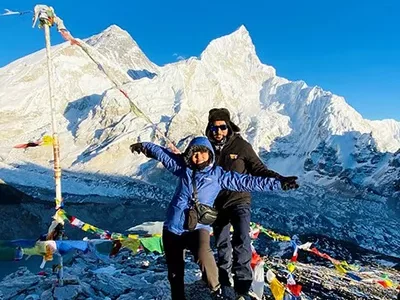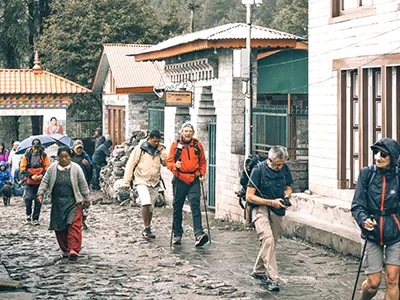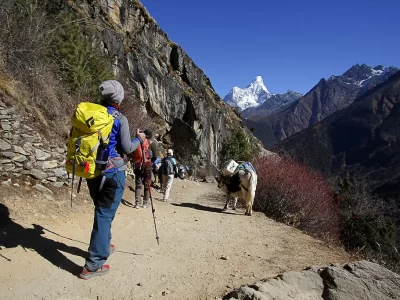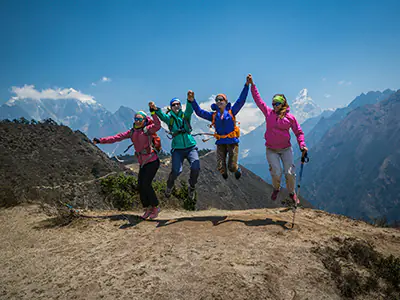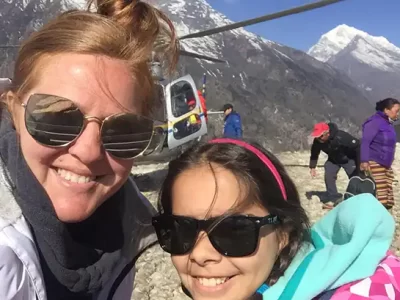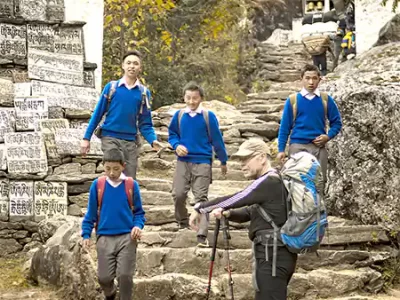Everest Base Camp Trek in June is a visual delight that enchants trekkers with its stunning landscapes. As the summer season unfolds in the Everest region, nature undergoes a remarkable transformation, creating a captivating tapestry of beauty that leaves a lasting impression on all who embark on this adventure.
The trek begins amidst vibrant rhododendron forests, where a riot of colors unfolds. Blossoming in red, pink, and white, these flowers paint the surroundings with their vibrant hues, creating a striking contrast against the backdrop of snow-capped peaks. Walking through these enchanting forests, trekkers are treated to the melodic sounds of native birds and occasional glimpses of wildlife, adding to the immersive experience of being in nature.
Ascending higher into the Khumbu region, trekkers are rewarded with awe-inspiring views of the Himalayan giants. The mighty peaks, including the legendary Mount Everest, Lhotse, Nuptse, and Ama Dablam, proudly display their majestic snow-covered summits, glistening under the sun’s golden rays. Beholding these majestic giants elicits a deep feeling of awe and reverence, serving as a poignant reminder to hikers of the immense power and breathtaking magnificence inherent in the realm of nature.
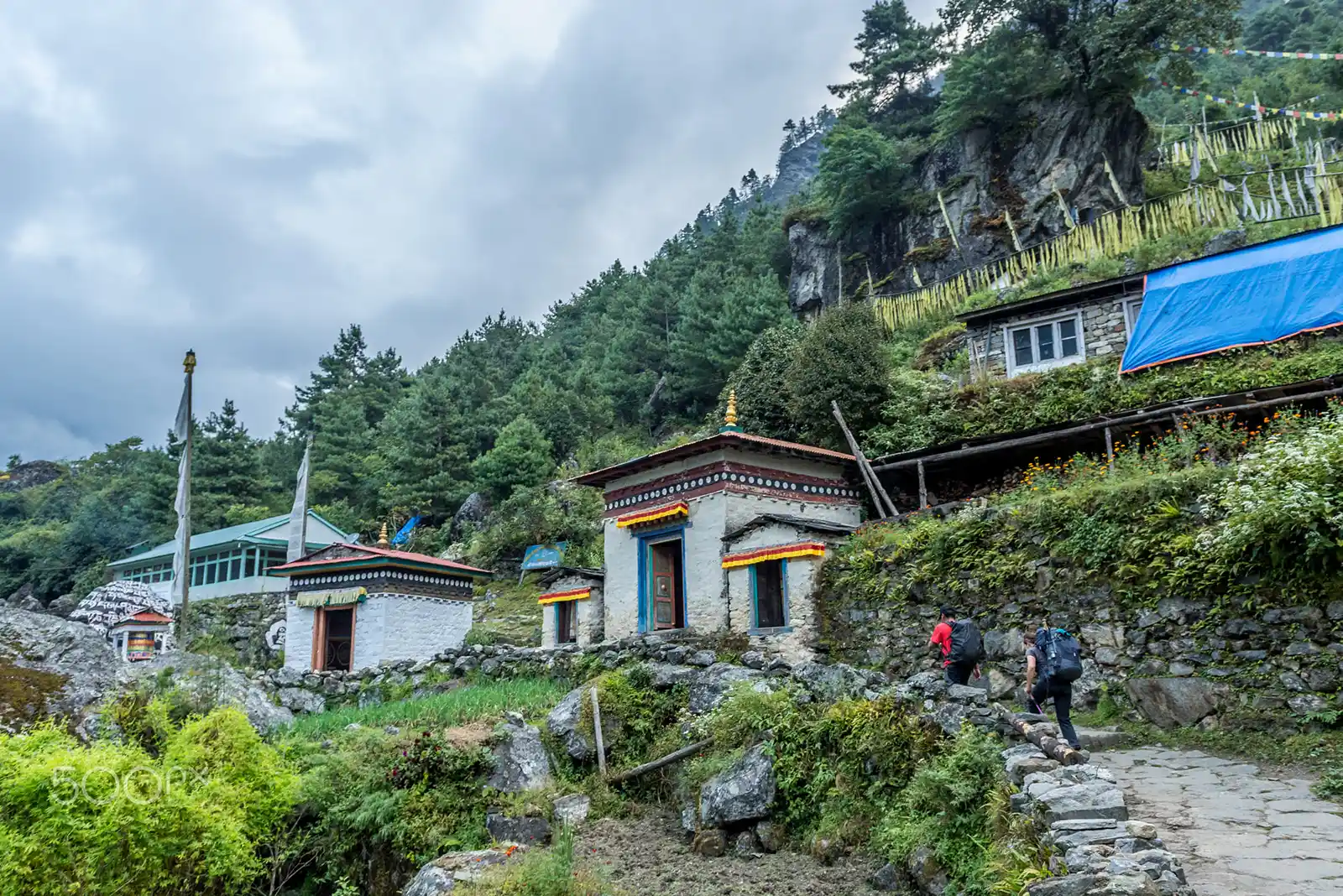
Glacial rivers carve through the valleys throughout the trek, adding to the picturesque scenery. Crossing sturdy suspension bridges over turquoise-hued streams offers an exhilarating experience, accompanied by the soothing sounds of rushing water. The landscapes constantly change, from emerald meadows to rocky terrains and cascading waterfalls, creating a dynamic visual feast that captivates the senses.
As trekkers approach Everest Base Camp, they enter a realm of pristine snowfields and icy landscapes. The breathtaking panorama of the Khumbu Glacier, with its serpentine crevasses and towering ice formations, is a sight to behold. The surreal beauty of the landscape, combined with the sense of accomplishment, makes reaching Everest Base Camp in June an indescribable moment of triumph and awe.
Blossoming Landscapes: The Vibrant Flora of the Everest Region
The Everest region boasts a wide variety of flora, and one of the most remarkable displays occurs in rhododendron forests. These magnificent trees burst into bloom during the summer months, painting the landscape with vibrant shades of red, pink, and white. Seeing these blooming rhododendrons against the backdrop of the soaring Himalayan peaks creates a breathtaking spectacle that leaves trekkers in awe.
Beyond the rhododendrons, the Everest region also has many other colorful flowers. Wildflowers such as primroses, poppies, and blue irises add color to the rugged terrain, creating a striking contrast against the rocky landscape and snow-capped peaks. These blooms, with their delicate beauty, remind us of the toughness and flexibility of plant life despite the harsh conditions here.
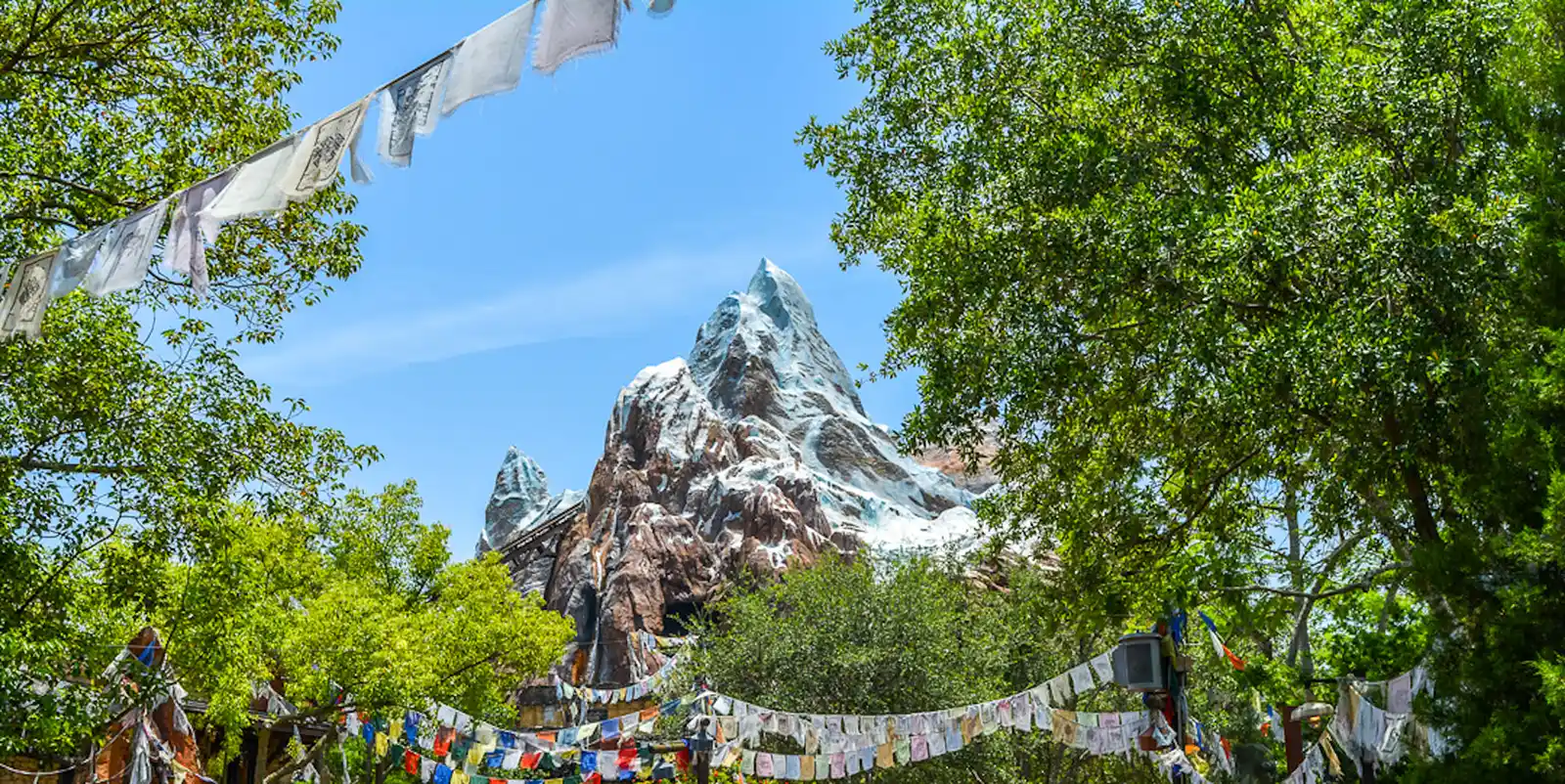
The significance of the flora in the Everest region extends beyond its aesthetic appeal. The rhododendron forests and other plant species play a crucial role in the ecosystem, providing habitat and food for various animal species. They help maintain the region’s natural harmony and variety. Understanding and appreciating the ecological importance of these plants adds depth to the trekking experience, allowing trekkers to connect with the natural environment on a deeper level.
As trekkers traverse these blooming landscapes, they are enveloped in a sensory experience like no other. The vibrant colors, intoxicating scents, and the delicate touch of petals against their skin create lasting memories. Each step taken through these floral wonders reveals nature’s artistry, offering a visual feast that complements the grandeur of the towering mountains.
Everest Base Camp Trek
Luxury Everest Base Camp Trek
Everest Base Camp Short Trek
Majestic Peaks: Awe-Inspiring Himalayan Panorama
Our adventure commences as we embark on a captivating expedition to discover the awe-inspiring Himalayan summits that reign over the renowned Everest Base Camp Trek path. Focusing on iconic summits like Mount Everest, Lhotse, and Ama Dablam, we aim to describe their grandeur, unique features, and profound emotional impact on trekkers.
Mount Everest, the tallest peak in the world, stands as a majestic sentinel, drawing trekkers from all corners of the globe. It’s towering presence and snow-capped summit elicit a sense of awe and admiration. As trekkers catch their first glimpse of Everest, they are often overcome with excitement, reverence, and a profound realization of the remarkable human spirit that has dared to conquer this colossal peak.
Lhotse, the fourth-highest mountain in the world, stands near Everest, adding to the awe-inspiring panorama. With its steep icy slopes and prominent pyramid-shaped summit, Lhotse captures the imagination of trekkers. The ever-shifting interplay of light and shadow upon its rugged visage throughout the day gives rise to a captivating spectacle that etches a profound and enduring impression.
Ama Dablam, known as the “Matterhorn of the Himalayas,” is another iconic peak that captivates trekkers. Its elegant and symmetrical form, adorned with ice and granite, presents a vision of sublime beauty. Ama Dablam’s unique silhouette against the azure sky is a constant companion throughout the trek, inspiring a sense of wonder and reverence for the power of nature.
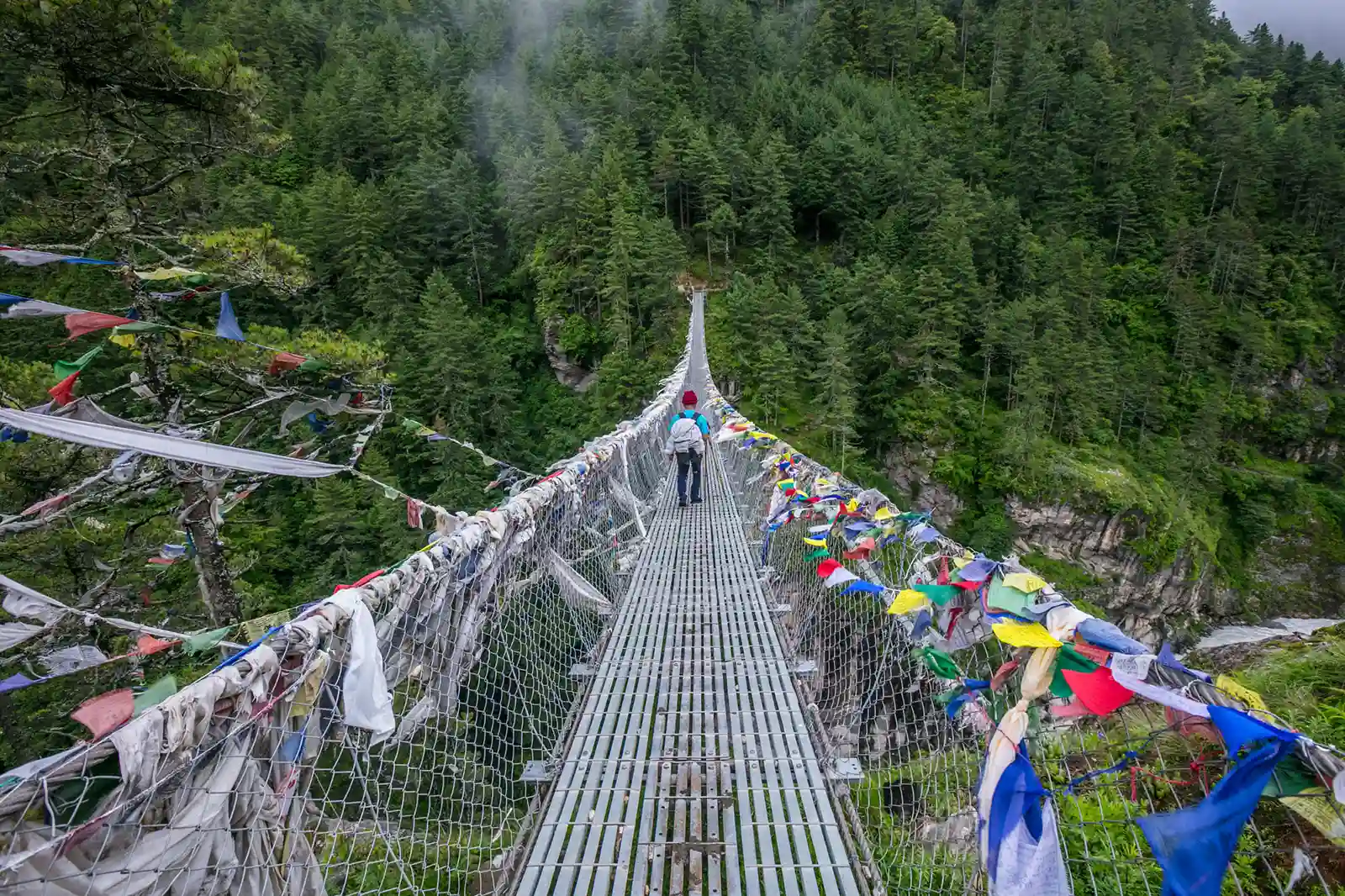
These peaks leave trekkers in awe of their magnificence and evoke deep emotional responses. They symbolize the triumph of human perseverance, as countless mountaineers have challenged their slopes in pursuit of adventure and personal achievement. Learning about the daring expeditions, the triumphs, and the tragedies that have unfolded on these peaks adds a layer of storytelling that resonates with trekkers, creating a sense of connection to the rich history and legacy of the mountains.
Captivating anecdotes and facts about these iconic summits further enhance the exploration. Sharing stories of legendary climbers, remarkable records, and the triumphs of the human spirit adds depth and context to the trekking experience. Such tales ignite the imagination and inspire trekkers to push their boundaries, embracing the spirit of adventure these peaks represent.
Changing Landscapes: From Verdant Valleys to Snowy Wonders
We set off on an exciting journey across the many landscapes seen on the Everest Base Camp Trek in June. The journey takes us from lush green valleys to awe-inspiring snowy terrains, and we delve into how the scenery evolves as trekkers ascend, highlighting the transitions, contrasts, and the sense of awe inspired by the changing vistas.
At the beginning of the trek, trekkers are greeted by verdant valleys adorned with dense forests and vibrant flora. The fresh aroma of blossoming wildflowers fills the air. As we traverse these fertile valleys, the trail winds along meandering rivers offer picturesque views of cascading waterfalls and lush vegetation. Trekkers find themselves immersed in a peaceful and tranquil setting, surrounded by the harmonious melodies of nature.
Everest Base Camp Trek in June progresses, and trekkers steadily gain altitude; the landscape transforms remarkably. The lush greenery gives way to rugged terrain with rocky slopes and alpine meadows. The verdant valleys gradually give rise to barren yet captivating landscapes. A distinct contrast marks the transitions as trekkers witness the delicate balance between life and harsh conditions that define high-altitude environments.
The snow-capped Himalayan peaks draw closer with each step, and trekkers find themselves amidst a snowy wonderland. The landscape seems otherworldly and beautiful, with a fresh coating of snow. The silence is profound, broken only by the crunching sound of snow beneath trekkers’ boots. The sparkling snow, shimmering in the sunlight, reflects the grandeur and serenity of the surroundings. The vast expanse of snow-capped peaks and glaciers evokes a sense of insignificance and humility, reminding trekkers of nature’s immense power and beauty.
The changing landscapes captivate the eyes and evoke emotions within trekkers. The ever-changing landscape evokes an unrivaled feeling of amazement and wonder. To witness the transition from the vibrant vitality of the valleys to the austere allure of the snow-clad highlands is an experience that humbles the soul. The contrast between the different landscapes is a constant reminder of the resilience of life and the ever-changing nature of the natural world.
Rivers and Waterfalls: Nature’s Serenades
We delve into the captivating beauty of glacial rivers and enchanting waterfalls encountered during the Everest Base Camp Trek in June. These natural features hold immense significance as they create picturesque scenes and provide refreshing moments for trekkers amidst the breathtaking surroundings.
Throughout the trek, trekkers are accompanied by the tranquil flow of glacial rivers that wind their way through the valleys. Nourished by the cascading snow and ice of the towering Himalayan summits, these rivers proudly display pristine waters, mirroring the enchanting panorama that envelops them. The sight of these pristine rivers, with their azure hues and gentle currents, creates mesmerizing vistas that leave trekkers in awe. The tranquil setting is enhanced by rushing water, making for a more enjoyable hiking experience.
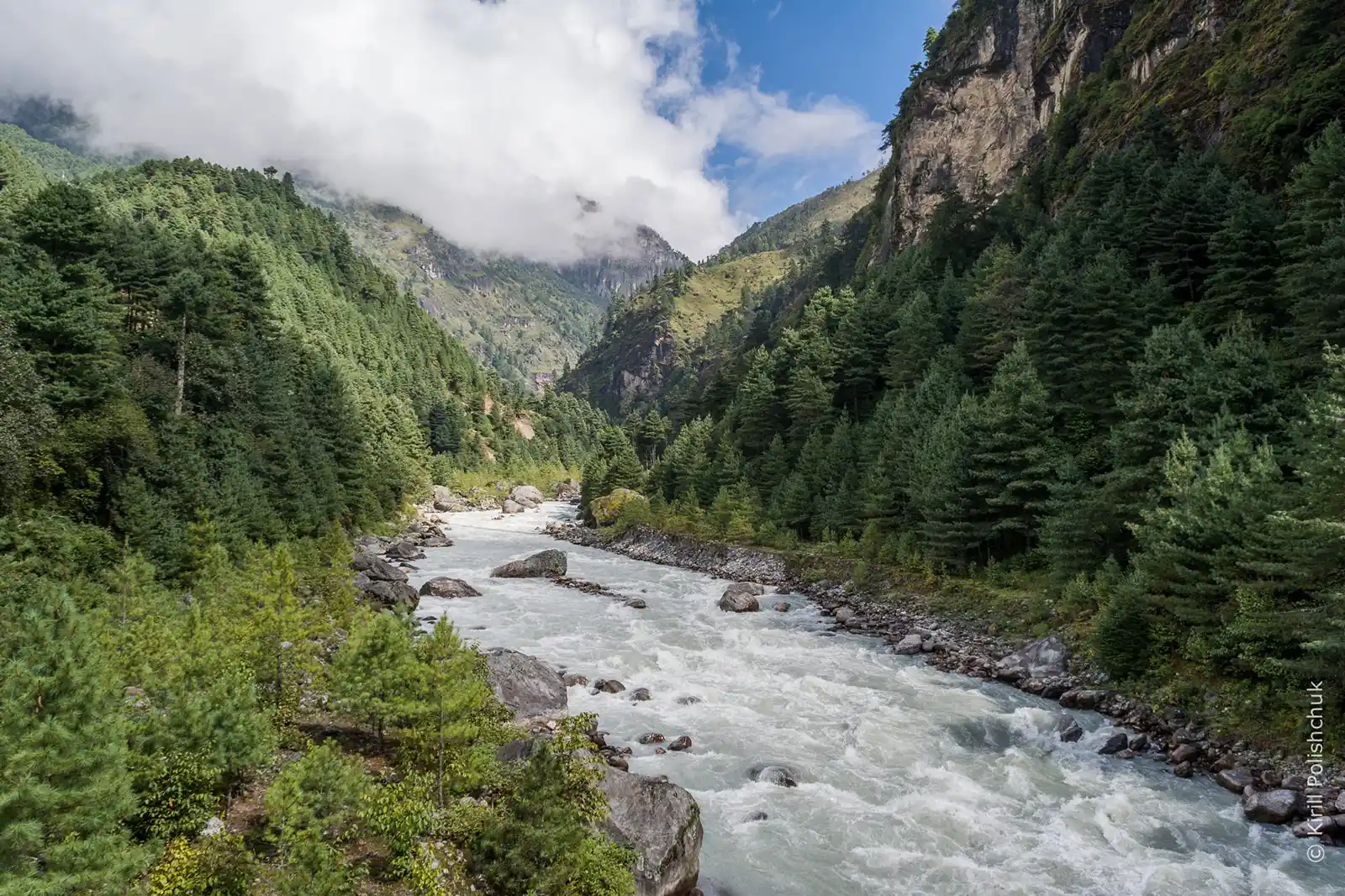
As trekkers follow the trails carved by these rivers, they are treated to captivating views at every turn. The rivers have sculpted the valleys over centuries, creating a dramatic and dynamic landscape. The lush greenery of the vegetation contrasts beautifully with the sparkling waters, offering a visual feast for trekkers. These rivers also play a vital role in sustaining the local ecosystem, providing hydration to the surrounding flora and fauna, and serving as a lifeline for the communities that call this region home.
Enchanting waterfalls cascade down the mountainsides alongside the glacial rivers, adding to the natural serenade. These cascades, formed by the rivers as they navigate the rugged terrain, create a symphony of nature’s melodies. The sight of water gracefully tumbling down the rocks and the refreshing mist filling the air offers trekkers respite and rejuvenation. These waterfalls enhance the visual appeal and serve as reminders of nature’s raw power and beauty, providing trekkers with a deeper connection to the natural world.
In conclusion, the glacial rivers and enchanting waterfalls encountered during the Everest Base Camp Trek in June contribute to the enchanting journey. Their crystal-clear waters, picturesque views, and soothing presence create a serene ambiance that immerses trekkers in the beauty of their surroundings. These natural wonders captivate the eyes and play a vital role in sustaining the ecosystem and offering moments of tranquility. The rivers and waterfalls embody nature’s serenades, adding an element of enchantment to the trekking experience.
Everest Base Camp Trek for Beginners
Everest Base Camp Trek with Helicopter Return
Everest Panorama Trek
Wildlife Encounters: Fauna of the Everest Region
We explore the fascinating world of wildlife encountered during the Everest Base Camp Trek in June. This subtopic highlights the diverse range of animals, including birds, mountain goats, and other native species, that inhabit this region. We delve into exciting facts about these creatures, their habitats, and the joys of observing them in their natural environment.
As trekkers travel through the Everest region, they can encounter various wildlife. The region is home to numerous bird species, each adding their unique charm to the trekking experience. Colorful Himalayan Monals, known for their vibrant plumage, grace the forests with their presence. Majestic eagles soar high above, showcasing their impressive wingspan. The musical calls of various bird species fill the air, creating a delightful symphony of nature’s sounds. Observing these feathered creatures in their natural habitat provides trekkers with a sense of awe and a deeper appreciation for the intricate biodiversity of the region.
Mountain goats like the Himalayan Tahr can be spotted effortlessly traversing the terrain among the rugged slopes and rocky cliffs. With their sure-footed agility, they gracefully navigate the steep slopes, showcasing their impressive adaptation to the mountainous environment. These iconic animals add a touch of wilderness and adventure to the trek, capturing the imagination of trekkers as they witness these magnificent creatures in their element.
Exploring the diverse wildlife of the Everest region also reveals the delicate balance between nature and the environment. It is essential to approach these encounters with respect and appreciation, allowing these animals to thrive undisturbed in their natural habitats. Such unique and beautiful wildlife further enriches the trekking experience, reminding us of the wonders beyond human civilization and inspiring a deeper connection with the natural world.
In conclusion, the Everest Base Camp Trek in June allows hikers to see various animals up close. From the vibrant bird species filling the air with their calls to the agile mountain goats gracefully navigating the rugged slopes, the region’s fauna adds a sense of wonder and fascination to the trek. Observing these creatures in their natural environment allows trekkers to appreciate the intricate biodiversity of the Everest region and forge a deeper connection with the remarkable wildlife that calls this place home.
Photography Tips: Capturing the Beauty of the Everest Base Camp Trek in June
We give hikers helpful pointers and hints on taking images that truly capture the wonder of their travels. This subtopic focuses on composition, lighting, and recommended equipment, helping trekkers make the most of their visual experience and preserve their memories in captivating images.
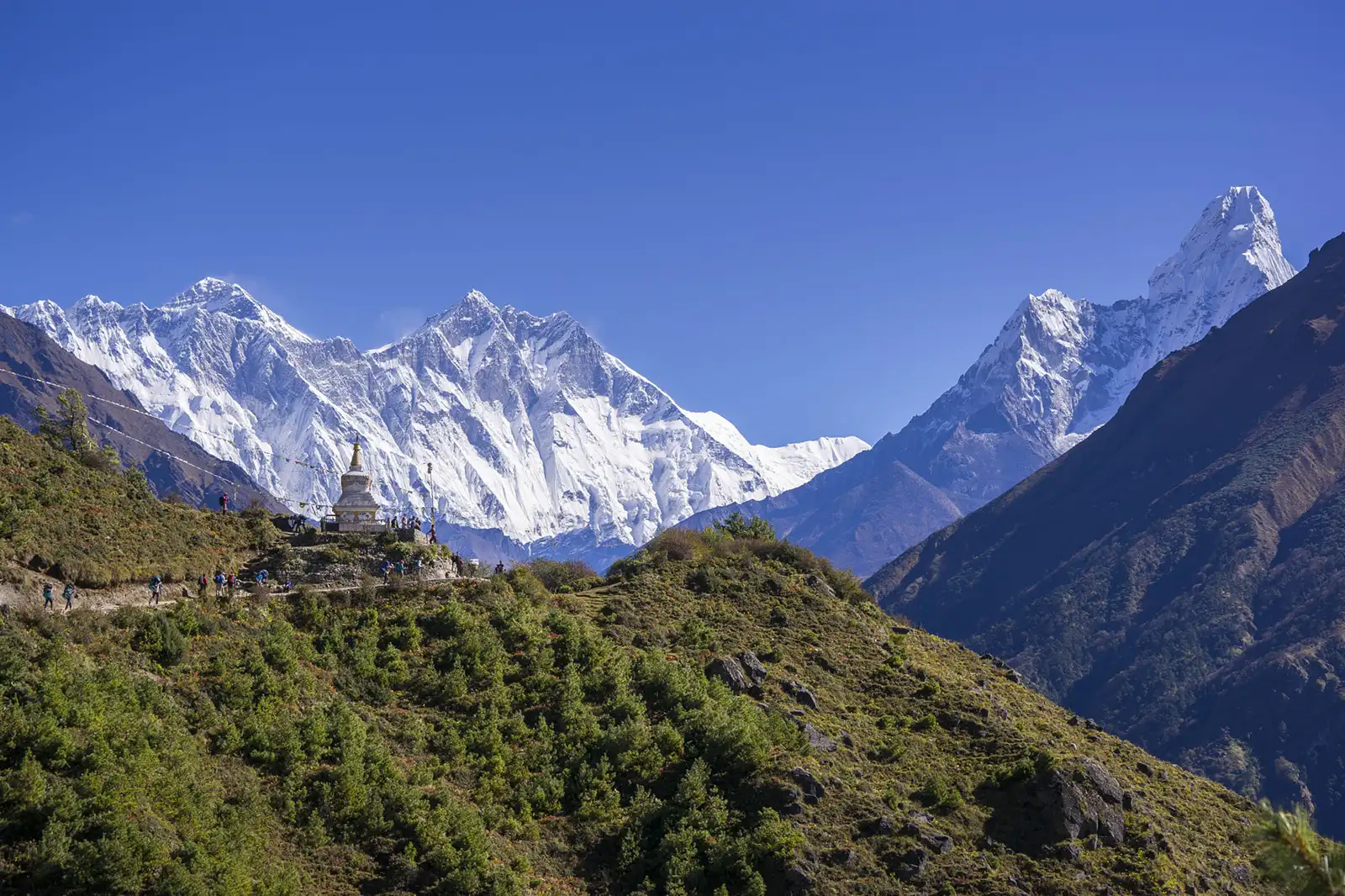
Composition is critical when it comes to photography, and the Everest Base Camp Trek offers a plethora of breathtaking scenes to frame. Encourage hikers to use different angles, viewpoints, and framing strategies to make aesthetically attractive images. Suggest using natural elements such as rocks, trees, or prayer flags as foreground interests to add depth and context to their shots. Remind them to pay attention to the rule of thirds, balancing the elements within the frame for a harmonious composition.
Lighting plays a crucial role in photography, and the Everest region offers a diverse range of lighting conditions throughout the day. Encourage trekkers to take advantage of the soft, warm light during sunrise and sunset, also known as the golden hour, to capture the mountains in their most enchanting glow. Remind them to be mindful of harsh midday sunlight, which can create strong shadows and contrast. Suggest using diffusers or adjusting exposure settings to maintain balanced lighting in challenging conditions.
When it comes to equipment, trekkers should prioritize portability and versatility. Recommend carrying a lightweight DSLR or mirrorless camera with a versatile lens, such as a wide-angle lens to capture vast landscapes and a telephoto lens for detailed shots of wildlife or distant peaks. Advise them to pack extra batteries and memory cards, as charging and data transfer facilities may be limited along the trek. Additionally, suggest using a sturdy tripod for stability during long exposures or self-portraits.
Lastly, remind trekkers to immerse themselves at the moment and not solely focus on capturing photographs. Please encourage them to take breaks from the lens, soak in the surroundings, and truly experience the beauty of the Everest Base Camp Trek. Remind them that the best photographs often convey the emotions and stories of the journey.
In summary, capturing the beauty of the Everest Base Camp Trek in June through photography requires a thoughtful approach. By mastering composition, understanding lighting conditions, and using suitable equipment, trekkers can create stunning images that reflect their journey’s awe-inspiring landscapes and unique experiences. Please encourage them to balance their desire for photographs with being present at the moment, ensuring they fully appreciate the visual splendor and create lasting memories of their trek.

